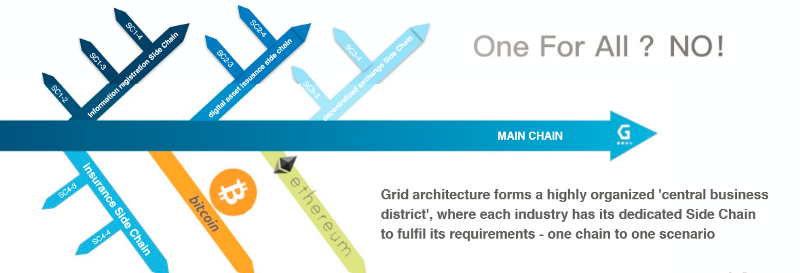Introducing aelf: The New Generation of scalable Blockchain, using multi-chain structure and parallel processing
The Blockchain community has witnessed rapid development in the past few years. Firstly it emerged as a secured decentralized P2P transfer mechanism and Satoshi’s Bitcoin proved the concept of decentralized crypto-currency. Ethereum then contributed to the community with successful implementation of versatile “Smart Contracts” and it unleashed great potential of Blockchain into numerous applications and industries.
However, this is only the dawn of Blockchain, as the boundary between the Blockchain Community and the business world has yet to be broken. We are at a turning point that the next phase of Blockchain will lead the integration between Blockchain and the physical business world, and inevitably bring in much more solid digital assets.
However, this is only the dawn of Blockchain, as the boundary between the Blockchain Community and the business world has yet to be broken. We are at a turning point that the next phase of Blockchain will lead the integration between Blockchain and the physical business world, and inevitably bring in much more solid digital assets.
Business scenarios vary in objectives and requirements and there are two examples to illustrate the differences. First, industries have different commercial requirements. For example, supply chain systems and trading platforms need fast confirmation, while medical and IP systems apt for a stable and secure network. Second, every industry evolves rapidly. Their requirement of the Blockchain system should also evolve to fit into the ever-changing environment. Therefore, an ideal Blockchain has to possess the following qualities:
High efficiency and scalability to handle transactions/ applications at commercial scale
High flexibility to customize Smart Contracts to meet the needs of different industries
High adaptability to new technology in the future
High compatibility to allow communication across public and private Chains and existing Blockchains
For now, Blockchain technology has three problems, namely limited performance, lack of resource segregation, and a working governance model. Traditional Blockchain systems often use linear processing with low transaction speed and limited scalability, which result in high gas fees and time to confirm transactions. The second drawback of existing chains is the over complex data structure and too many different smart contracts on one chain. It hinders efficiency and leads to system congestion if one contract takes too many resources (e.g. Bancor ICO). Last is the governance model, as we have seen the lasting arguments on bringing new features to Bitcoin Blockchain in its community.

aelf has its own thinking. Our view is that one Blockchain may not be sufficient to fulfill all of these requirements. aelf establishes a Blockchain system, which functions as an operating system similar to Linux.
To optimize the performance, aelf will run nodes on clusters. It will allow assigned transactions to different groups based on mutex of the transactions. Transactions within a group will be processed in linear sequence, while all groups will be processed simultaneously. The Main Chain will adopt DPoS consensus protocol to ensure high TPS and predictability of Block formation. The assigned node groups are elected by aelf token holders based on the node’s processing efficiency as well as their profitability.
In terms of resource segregation, aelf adopts a Main Chain + N Side Chains architecture, which means each business scenario has its dedicated Side Chain to fulfill its requirements. Together they form a ‘central business district’, where one chain is designed for one use case, distributing different tasks on multiple chains. By segregating resources, the processing efficiency of the whole system will be improved and system congestion will be greatly alleviated. In addition, to keep up with commercial innovation, aelf deploys a modular architecture, which defines basic components of minimum viable Block and Genesis Smart Contract Collection for each Chain to reduce complexity. Commercial users are able to design their Chain via APIs.
For a better ecosystem, aelf permits stakeholders to approve amendments to the protocols, including redefining the Consensus Protocol. aelf also permits Side Chains to join or exit from Main Chain dynamically based on stakeholder voting, therefore introducing competition and incentive to improve each Side Chain. A better governance model will be achieved through this voting mechanism.
Our infrastructures will continuously evolve with the participation of more commercial users, forming a vibrant commercial Blockchain eco-system. aelf believes that open source is good for everyone. If you’re a developer, you are very welcomed to contact us through telegram, slack etc. To make a better Blockchain ecosystem, we are doing our best to make aelf a real breakthrough.
Up next, aelf Foundation, established in Singapore, will promote aelf technology development and applications, facilitating corporates and startups to establish new business and transform themselves in digital business. Technical development will be led by Beijing Hoopox Information and Technology Co., Ltd. Founded in June 2016, Hoopox focuses on providing Blockchain-based solutions for various industries. Hoopox has concluded its Pre-A funding of USD 4.3 million (RMB 28 million) from seven VCs, including China Growth Capital, Draper Dragon, WeX Fintech, Taoshi Capital, Danhua Capital, and Albatross Venture, and FBG Capital.
Hi! I am a robot. I just upvoted you! I found similar content that readers might be interested in:
https://medium.com/@aelfblockchain/introducing-grid-the-new-generation-of-scalable-blockchain-using-multi-chain-structure-and-7980c089eca4
We move from medium to steemit